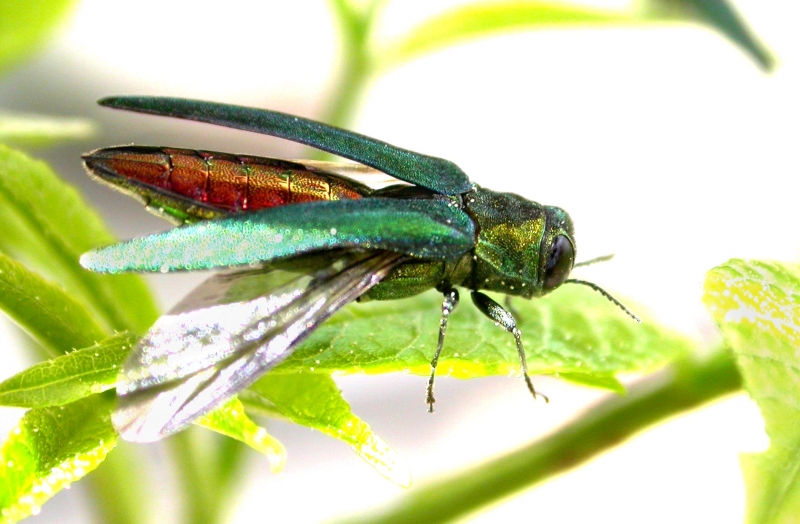
Emerald Ash Borers may be pretty at first glance, but the toll they take on native ash trees isn't a pretty sight. Photo: Flickr Creative Commons, USDA
Invasive Species Awareness Week
In Grade 3, a brilliant joke made the rounds. We’d hold up a sheet of blank white paper and announce it was a polar bear in a snowstorm. Genius is relative for kids. But the first time I drove into a whiteout made me realize how accurate that “art” project was. Anything can hide behind a veneer of snow.
This leads me to ask why February 26 – March 3 was chosen as “National Invasive Species Awareness Week.” By this time of year, our awareness has been blunted by a critical shortage of landscape: down is white, up is gray. Right now we’re aware it’s cold, and that the ground has been white for a long while. Seems like Microsoft or Elon Musk or whoever runs the “Special of the Week” calendar could find a better time for drawing folks’ attention to harmful invaders.
However, while invasive plants like garlic mustard and swallow-wort are nowhere to be seen, this is a perfect time to scout for certain invasive forest pests. The emerald ash borer (EAB), a glitzy, deadly beetle from China, was found at two locations in St. Lawrence County in 2017. Last August, volunteers from the St. Lawrence EAB Task Force discovered it in Hammond, and in December, foresters from the St. Regis Mohawk Environment Office found high numbers of EAB larvae near Massena.
The emerald ash borer kills green, black, and white ash, our native ash species, together about 10% of all North Country trees, by boring them to death. In the literal sense. Additionally, EAB pose a threat to public safety. Trees normally stand a few years after dying, but those killed by EAB become hazardous in 12 to 18 months, often collapsing under their own weight with no visible cause. This makes it important to identify ash trees, and to look for signs of EAB infestation.
In late winter and early spring, EAB larvae are active under the bark when sunshine hits the south and SW face of ash trunks. Woodpeckers sense this movement, and shave ash bark thin as they hunt the larvae. This causes “blonding,” conspicuous patches on ash trunks where bark is much lighter. These “blond” patches, a sign of EAB infestation, are easy to spot on sunny late-winter afternoons.
Another scary pest is the hemlock woolly adelgid (HWA), a tiny, aphid-like insect from Asia. Despite its small size, HWA are killing hemlock fir in NY State, moving northward faster than expected. In 2017 they were found near Lake George. Anyone who has hiked much, or enjoyed a cool shady ravine on a hot day, knows how prevalent and important hemlocks are. This tree is key to filtering and cooling waters in streams and rivers. Without hemlocks, many fish species would suffer huge losses or possibly even disappear from affected areas.
We expect aphids in summer, but their cousin the HWA is most active during the cold months. As they feed in winter, HWA secrete a white, waxy substance that covers and protects them. With good binoculars, their white “wool” can be seen in hemlock crowns. A sunny day in late winter is a good time to scout for HWA. If you ski or snowshoe, consider incorporating a few “HWA stops” to take out the thermos, trail mix and binoculars.
Another HWA scouting method involves a giant slingshot and a few tennis or squash balls decorated with adhesive Velcro strips. In a dense hemlock stand, the ball is fired straight up into the canopy, and if HWA are present, the Velcro is perfect for nabbing some of them. You need several balls, as there may be one or two that do not come down. Giant slingshots intended for tree (arborist) work, or for launching balls for dogs to retrieve, can send an object as high as 100 feet.
For more information on EAB, visit emeraldashborer.info or natureupnorth.org/emeraldashborer. To learn more about both HWA and EAB, go to natureupnorth.org/invasivespecies, adkinvasives.com or sleloinvasives.com. Please report any suspected invasive forest pests you find to your local New York State Department of Environmental Conservation or Cornell Cooperative Extension office.
And if you discover any polar bears in the snow, probably best to run.

